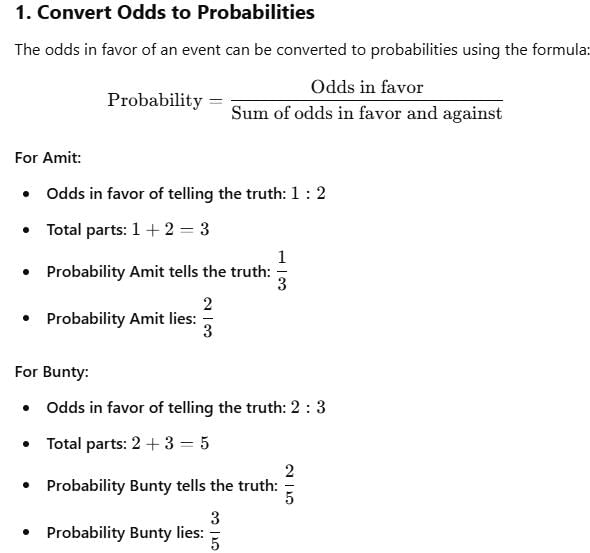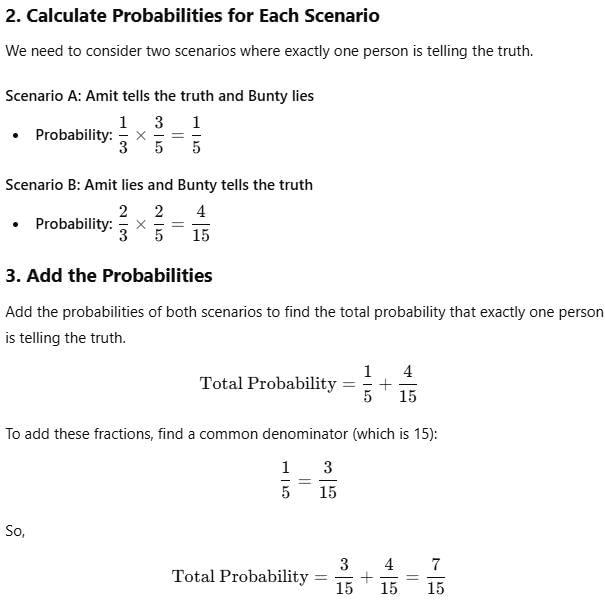GRE Exam > GRE Questions > The odds that Amit speaks the truth are 1:2 a...
Start Learning for Free
The odds that Amit speaks the truth are 1:2 and the odds that Bunty speaks the truth are 2:3. What is the probability that exactly one of Amit and Bunty is telling the truth?
- a)3/5
- b)4/15
- c)7/15
- d)4/7
- e)3/7
Correct answer is option 'C'. Can you explain this answer?
| FREE This question is part of | Download PDF Attempt this Test |
Most Upvoted Answer
The odds that Amit speaks the truth are 1:2 and the odds that Bunty sp...
Question Analysis:
In this question, we are given the odds of Amit and Bunty speaking the truth. We are asked to find the probability that exactly one of them is telling the truth.
Given information:
- The odds that Amit speaks the truth are 1:2.
- The odds that Bunty speaks the truth are 2:3.
Approach:
To solve this problem, we can use the concept of odds and convert the odds to probabilities.
We will calculate the probability that Amit is telling the truth and Bunty is lying, and then the probability that Amit is lying and Bunty is telling the truth. Finally, we will add these two probabilities to get the probability that exactly one of them is telling the truth.
Solution:
Step 1: Calculate the probability that Amit is telling the truth and Bunty is lying.
The odds that Amit speaks the truth are 1:2. This means that the probability of Amit telling the truth is 1/(1+2) = 1/3.
The odds that Bunty speaks the truth are 2:3. This means that the probability of Bunty lying is 3/(2+3) = 3/5.
Therefore, the probability that Amit is telling the truth and Bunty is lying is (1/3) * (3/5) = 1/5.
Step 2: Calculate the probability that Amit is lying and Bunty is telling the truth.
The probability that Amit is lying is 1 - 1/3 = 2/3.
The probability that Bunty is telling the truth is 2/(2+3) = 2/5.
Therefore, the probability that Amit is lying and Bunty is telling the truth is (2/3) * (2/5) = 4/15.
Step 3: Calculate the probability that exactly one of Amit and Bunty is telling the truth.
The probability that exactly one of them is telling the truth is the sum of the probabilities calculated in Step 1 and Step 2.
Therefore, the probability that exactly one of Amit and Bunty is telling the truth is 1/5 + 4/15 = 7/15.
Answer:
Therefore, the probability that exactly one of Amit and Bunty is telling the truth is 7/15. Hence, the correct answer is option C.
In this question, we are given the odds of Amit and Bunty speaking the truth. We are asked to find the probability that exactly one of them is telling the truth.
Given information:
- The odds that Amit speaks the truth are 1:2.
- The odds that Bunty speaks the truth are 2:3.
Approach:
To solve this problem, we can use the concept of odds and convert the odds to probabilities.
We will calculate the probability that Amit is telling the truth and Bunty is lying, and then the probability that Amit is lying and Bunty is telling the truth. Finally, we will add these two probabilities to get the probability that exactly one of them is telling the truth.
Solution:
Step 1: Calculate the probability that Amit is telling the truth and Bunty is lying.
The odds that Amit speaks the truth are 1:2. This means that the probability of Amit telling the truth is 1/(1+2) = 1/3.
The odds that Bunty speaks the truth are 2:3. This means that the probability of Bunty lying is 3/(2+3) = 3/5.
Therefore, the probability that Amit is telling the truth and Bunty is lying is (1/3) * (3/5) = 1/5.
Step 2: Calculate the probability that Amit is lying and Bunty is telling the truth.
The probability that Amit is lying is 1 - 1/3 = 2/3.
The probability that Bunty is telling the truth is 2/(2+3) = 2/5.
Therefore, the probability that Amit is lying and Bunty is telling the truth is (2/3) * (2/5) = 4/15.
Step 3: Calculate the probability that exactly one of Amit and Bunty is telling the truth.
The probability that exactly one of them is telling the truth is the sum of the probabilities calculated in Step 1 and Step 2.
Therefore, the probability that exactly one of Amit and Bunty is telling the truth is 1/5 + 4/15 = 7/15.
Answer:
Therefore, the probability that exactly one of Amit and Bunty is telling the truth is 7/15. Hence, the correct answer is option C.
Free Test
FREE
| Start Free Test |
Community Answer
The odds that Amit speaks the truth are 1:2 and the odds that Bunty sp...


Attention GRE Students!
To make sure you are not studying endlessly, EduRev has designed GRE study material, with Structured Courses, Videos, & Test Series. Plus get personalized analysis, doubt solving and improvement plans to achieve a great score in GRE.

|
Explore Courses for GRE exam
|

|
Similar GRE Doubts
The odds that Amit speaks the truth are 1:2 and the odds that Bunty speaks the truth are 2:3. What is the probability that exactly one of Amit and Bunty is telling the truth?a)3/5b)4/15c)7/15d)4/7e)3/7Correct answer is option 'C'. Can you explain this answer?
Question Description
The odds that Amit speaks the truth are 1:2 and the odds that Bunty speaks the truth are 2:3. What is the probability that exactly one of Amit and Bunty is telling the truth?a)3/5b)4/15c)7/15d)4/7e)3/7Correct answer is option 'C'. Can you explain this answer? for GRE 2024 is part of GRE preparation. The Question and answers have been prepared according to the GRE exam syllabus. Information about The odds that Amit speaks the truth are 1:2 and the odds that Bunty speaks the truth are 2:3. What is the probability that exactly one of Amit and Bunty is telling the truth?a)3/5b)4/15c)7/15d)4/7e)3/7Correct answer is option 'C'. Can you explain this answer? covers all topics & solutions for GRE 2024 Exam. Find important definitions, questions, meanings, examples, exercises and tests below for The odds that Amit speaks the truth are 1:2 and the odds that Bunty speaks the truth are 2:3. What is the probability that exactly one of Amit and Bunty is telling the truth?a)3/5b)4/15c)7/15d)4/7e)3/7Correct answer is option 'C'. Can you explain this answer?.
The odds that Amit speaks the truth are 1:2 and the odds that Bunty speaks the truth are 2:3. What is the probability that exactly one of Amit and Bunty is telling the truth?a)3/5b)4/15c)7/15d)4/7e)3/7Correct answer is option 'C'. Can you explain this answer? for GRE 2024 is part of GRE preparation. The Question and answers have been prepared according to the GRE exam syllabus. Information about The odds that Amit speaks the truth are 1:2 and the odds that Bunty speaks the truth are 2:3. What is the probability that exactly one of Amit and Bunty is telling the truth?a)3/5b)4/15c)7/15d)4/7e)3/7Correct answer is option 'C'. Can you explain this answer? covers all topics & solutions for GRE 2024 Exam. Find important definitions, questions, meanings, examples, exercises and tests below for The odds that Amit speaks the truth are 1:2 and the odds that Bunty speaks the truth are 2:3. What is the probability that exactly one of Amit and Bunty is telling the truth?a)3/5b)4/15c)7/15d)4/7e)3/7Correct answer is option 'C'. Can you explain this answer?.
Solutions for The odds that Amit speaks the truth are 1:2 and the odds that Bunty speaks the truth are 2:3. What is the probability that exactly one of Amit and Bunty is telling the truth?a)3/5b)4/15c)7/15d)4/7e)3/7Correct answer is option 'C'. Can you explain this answer? in English & in Hindi are available as part of our courses for GRE.
Download more important topics, notes, lectures and mock test series for GRE Exam by signing up for free.
Here you can find the meaning of The odds that Amit speaks the truth are 1:2 and the odds that Bunty speaks the truth are 2:3. What is the probability that exactly one of Amit and Bunty is telling the truth?a)3/5b)4/15c)7/15d)4/7e)3/7Correct answer is option 'C'. Can you explain this answer? defined & explained in the simplest way possible. Besides giving the explanation of
The odds that Amit speaks the truth are 1:2 and the odds that Bunty speaks the truth are 2:3. What is the probability that exactly one of Amit and Bunty is telling the truth?a)3/5b)4/15c)7/15d)4/7e)3/7Correct answer is option 'C'. Can you explain this answer?, a detailed solution for The odds that Amit speaks the truth are 1:2 and the odds that Bunty speaks the truth are 2:3. What is the probability that exactly one of Amit and Bunty is telling the truth?a)3/5b)4/15c)7/15d)4/7e)3/7Correct answer is option 'C'. Can you explain this answer? has been provided alongside types of The odds that Amit speaks the truth are 1:2 and the odds that Bunty speaks the truth are 2:3. What is the probability that exactly one of Amit and Bunty is telling the truth?a)3/5b)4/15c)7/15d)4/7e)3/7Correct answer is option 'C'. Can you explain this answer? theory, EduRev gives you an
ample number of questions to practice The odds that Amit speaks the truth are 1:2 and the odds that Bunty speaks the truth are 2:3. What is the probability that exactly one of Amit and Bunty is telling the truth?a)3/5b)4/15c)7/15d)4/7e)3/7Correct answer is option 'C'. Can you explain this answer? tests, examples and also practice GRE tests.

|
Explore Courses for GRE exam
|

|
Suggested Free Tests
Signup for Free!
Signup to see your scores go up within 7 days! Learn & Practice with 1000+ FREE Notes, Videos & Tests.
























